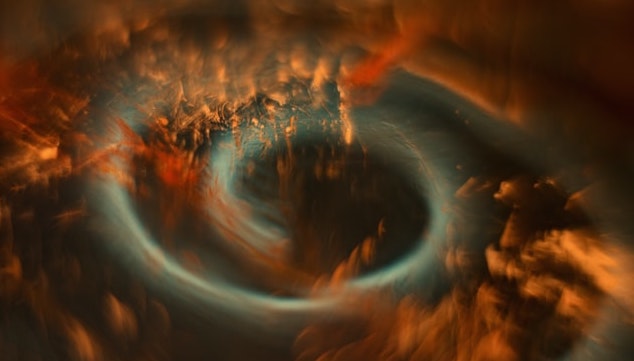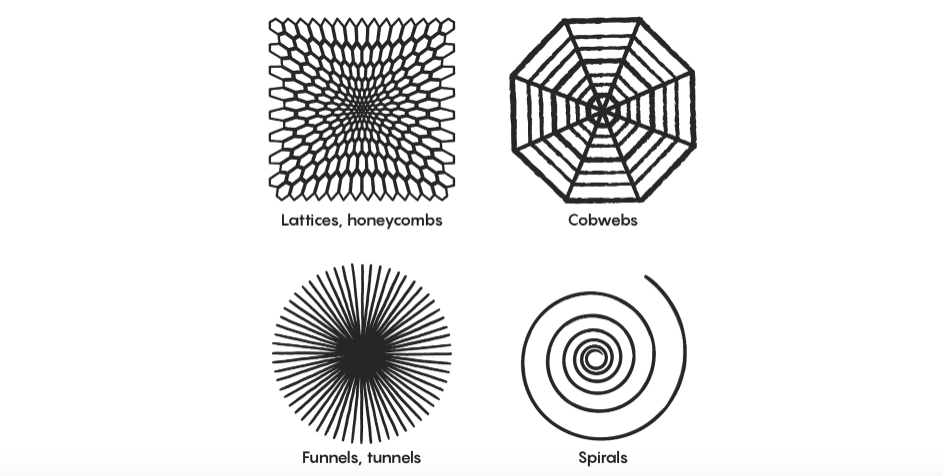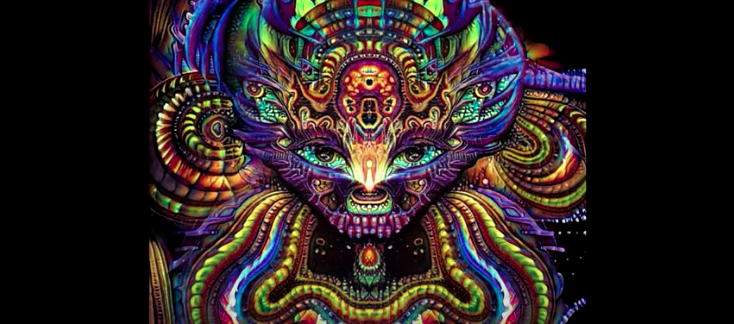These are experiences humans have sought since our ancient ancestors first took psychedelics. And yet, we still don’t really know what causes this amazing, freaky, and sometimes slightly scary phenomena.

Seems crazy right? But there’s still so much we don’t know about the mystery of human consciousness and psychedelics themselves. However, scientists and researchers are always plugging away trying to make that picture a bit clearer. Which brings us to the groovy news that some of these hard workers have managed to get an AI computer to start generating DMT visuals!
The History of Psychedelic Visual Research
And we’re not talking about the twirly screensaver that came with your laptop. These are real data driven images — and get this — the researchers were not aiming to come up with these images. The faces found them! Before we get into it however, let’s dip a toe into the long history of psychedelic visual research!
Psychonaut explorers and scholars have mapped the effects of psychedelics on our senses for many, many years. For example, in the 1920s Heinrich Klüver, a perceptual psychologist at the University of Minnesota continued the grand tradition of be-your-own-guinea pig experimentation by dosing himself with peyote. As part of his research into hallucinations he documented his visual changes during his trip. He noticed that many of the patterns that recurred shared significant similarities with forms found in ancient cave art, as well as the abstract paintings of Joan Miró. This made him speculate that such shapes were innate to human vision — i.e. something all of our brains are able to naturally project or create.

Four Key Psychedelic Patterns
He identified four types of visual patterns that he named “form constants.” These were spirals, tunnels, cobwebs and littices (i.e. checkerboards, triangles and honeycombs.) Fifty years after this Jack Cowan and Bard Ermentrout of the University of Chicago attempted to use mathematical theories to reproduce these form constants identified by Klüver. They believed that this could help to visualize the brain’s circuitry. In 1979 they released a paper that showed that the neurons in the first layer of the visual cortex displayed electrical activity that could be directly translated into the typical geometric fractals people see while tripping. This means that the hallucinations we see may be a replication of the architecture and form of the brain’s neural network. As Cowan explained;
“The math of the way the cortex is wired, it produces only these kinds of patterns,”

The AI Begins To Make Faces…
This leads us to where we find ourselves today; AI generating psychedelic visuals at the behest of researchers. For this particular project Josie Kins, a psychedelic researcher, who with a team of collaborators, created an AI model using the StyleGAN v2 network. They then ‘trained’ the model by inputting data of over 4,000 psychedelic and visionary art images from across the internet. Kins’ role as the admin of /r/Replications, a Reddit community focused on sharing and collecting images and replications of Altered States of Consciousness (ASCs), was key in amassing these images.

The AI, after chowing down on all these images began to generate the usual fractal and geometrical patterns associated with all psychedelics. However, it soon began to generate faces. Faces that resembled what Terence McKenna referred to as ‘machine elves’. These psychedelic creatures are known as one of the common conjurings of the mind while on DMT. DMT hallucinations are known to be quite distinct from other psychedelic visuals: for example on /r/Replications user ‘abomnibot’ shares;
“DMT was always much…sharper for me? I always thought it looked kind of digital if that makes sense as opposed to lsd or mushrooms which have always been much more fluid and…melty?”
Meeting the Machine Elves
Around one in thirty of the visuals produced by the AI contained these creatures. It is fascinating that a computer, trained to think like us, would also generate such images. It is also interesting that the drug hallucinations described as most ‘digital’ were what a machine plumped for. Stick with what you know I guess!
Many people who experience DMT trips in which they meet these machine elves, or DMT entities, rank it as a highly meaningful and important experience. In 2020 the Journal of Psychopharmacology published a study which surveyed 2,561 adults who had experienced meetings with these entities while on DMT. 99% of those surveyed had an emotional response, which were generally positive, with 65% experiencing ‘joy’, and 59% feeling ‘love’. Additionally, ¾ of those surveyed believed that these creatures were from another world, reality or dimension.
We could (if we were being dramatic) suggest this AI system is revealing beings from another dimension to us! Now there’s a thought…
The Psychonauts Have Their Say
Although it’s fascinating stuff, many psychonauts believe there are variables that just can’t be quantified into a mathematical or algorithmical formula. So much of psychedelic visuals are also caught up in our lived experience, our mood, our dreams and fears and our environment. Of course the AI had been fed a thousand images but it can’t quite input the emotional response and real individual feelings a person experiences.
On /r/Replicators user ‘jake_megabyte’ states;
“…most replication are simply based on the idea that “fractals” and “geometry” is the core of psychedelic visions… bull****. High dose mushrooms was literally like being abducted by flying saucer aliens. I almost feel like most people who claim to understand psychedelics are taking sub threshold doses. It’s not just shapes and colors. You go to an alien world.”
While another ‘JovahkiiinVIII’ reckons;
“Honestly I don’t think it’s possible on 2d screens. We have an inherent sense of depth and 3d space that means we can hallucinate things that are not only impossible to exist, but impossible to represent in any contemporary medium.”
Stay Tuned For More Fractals!
Computers may never be able to completely grasp the spiritual experience that humans go through while on a psychedelic trip. While it is true that these geometric fractals are a key part of the visual hallucination — each person, as well as psychedelic, has their own individual flavor, which will affect the experience. However, what we can agree is that these accidental DMT visuals are super cool. And a form of psychedelic art on their own. After all, they’re based on human-made images that represent real psychedelic experience.
Pleased and surprised with their results, Kins and her team are working on an even more advanced AI model to produce more and better ‘replications’. So if you’re craving some tasty new fractals you may not have to wait for too long! For now, check out the amazing video in full right here!





